Lip blisters are extremely common issues that we have all experienced at least once. You may know them as cold sores, fever blisters, or water blisters. But, regardless of their name, the one thing that all of these blister on lip lesions have in common is that they are absolutely unnerving.
They are almost impossible to conceal because they are located on the face, which always causes additional stress. Even the best makeup products appear unable to cover up these sores completely. Moreover, these lesions seem to come up in the worst possible moments, like important job meetings, exams, or dates.
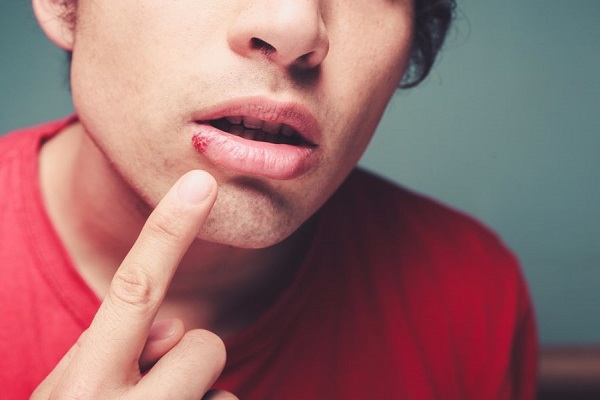
In this article, we will explain exactly why this happens, and how you can make it stop. We will describe the main types of lip blisters, and look at the blister on lip causes. Then, we will present the best ways to treat them correctly, as well as the main preventative measures you can take to make them stay away for good.
The Main Types of Lip Blisters and What Causes a Blister on Lip
Cold sores, water blisters, and canker sores are all excruciatingly annoying, but they are, in fact, very different. Each type of blister on lip has its own causing agent, which makes the treatment plan different as well. In this section of our article, we will describe the main types of blister on lip lesions, and the main pathological agents that cause them.
Cold Sores or Fever Blisters
Cold sores, otherwise known as fever blisters, are some of the most common blister on lip lesions. They are caused by a virus, which makes them more difficult to treat than other lip blisters. Furthermore, these lesions are recurrent.
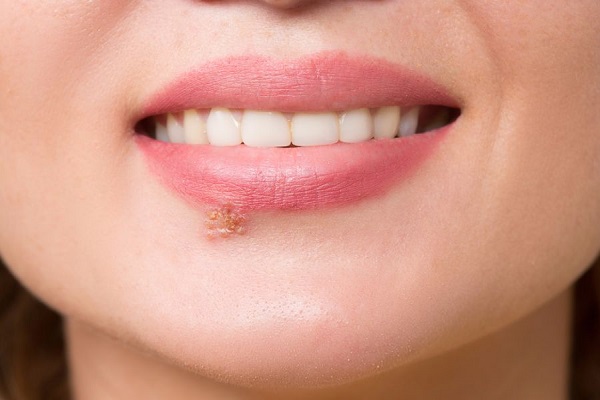
Cold Sores Causes
Cold sores are caused by the Herpes simplex virus type 1 (HSV-1). The HSV-1 is so common that the vast majority of people become infected even before the age of 10. The virus is transmitted through oral-to-oral contact, as well as oral-to-skin contact.
The main reason for the high prevalence of this virus is that infected people can transmit the virus even when they do not present symptoms (cold sores). As such, most people contract the HSV-1 virus and develop a cold sore, after which they become asymptomatic. However, they will remain carriers of the virus for the rest of their lives.
Recurring Cold Sores and Stress
People who carry the HSV-1 virus remain asymptomatic because their immune system will limit the development of the virus. However, when the action of the immune system becomes weakened, the virus reemerges, which causes new cold sores to develop.
Stress, complex medical procedures, and other diseases weaken the immune system and essentially cause the HSV-1 virus to re-emerge. In fact, this is why cold sores have the tendency to appear in highly stressful moments.
Furthermore, this is why these blister on lip lesions are also known as “fever blisters”. If the immune system is focused on limiting an infection (which causes the fever), its action on the HSV-1 virus is reduced, which enables it to cause lesions (cold sores).
Cold Sores Description (Tiny Blisters on Lips)
Cold sores usually appear on the border of the lip. In the beginning, a small portion of the edge of the lip the size of a small fingernail becomes inflamed and reddish. This part is usually painless. About one day later, several tiny blisters on lips appear in the affected area.
These blisters become slightly larger the following day. The inflammation around the affected area also becomes more intense at this point. Patients may also experience local pain. The blisters typically recede in a week’s time. In more complicated cases, it may take as long as 10 days before all the blisters are fully cured.
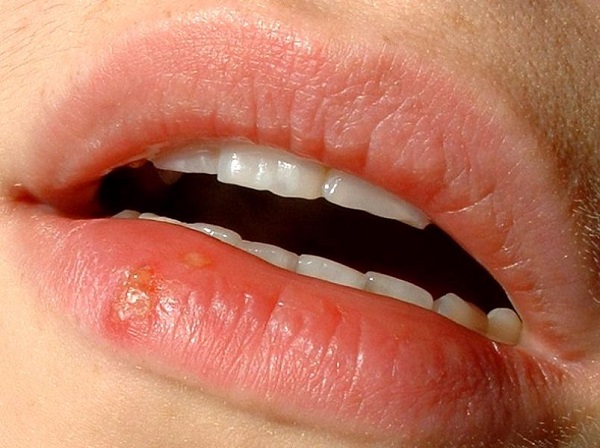
If the cold sores do not recede in a week’s time even with the proper treatment, we strongly advise patients to go see a doctor. They may need a more complex treatment plan for their cold sores, and it is extremely important that they perform it under medical supervision.
Sun Blisters on Lips (Little Blisters on Lip)
This type of lip blisters occur frequently during summertime and look little blisters on lip. They are essentially sun burns located on the lip area. As such, they are very different from cold sores. Here is some general information on sun blisters:
- Sun blisters are caused by exposing the lip area to the sun, and not by the Herpes virus.
- These blisters are not contagious, unlike gingivitis, which can be transmitted through kissing!
- Sun blisters must be treated like low-grade sunburns (No antiviral medicine required!)
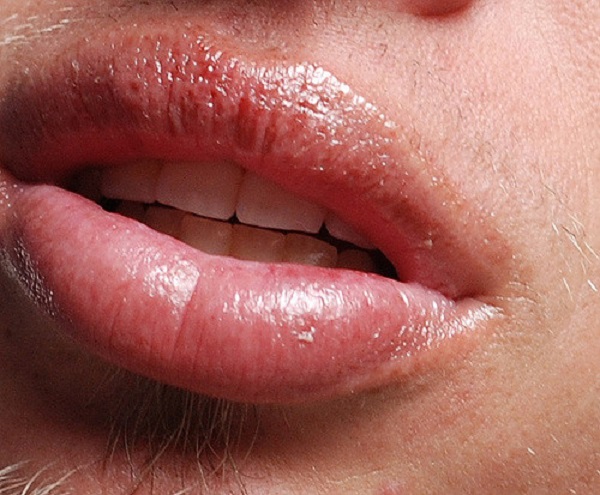
Sun Blister on Lip – Causes
These blister on lip lesions are caused by the UV rays in sunlight or tanning beds, which damage the sensitive skin from the lip area. In fact, they are second-degree sunburns, which typically present with blisters. Sun blisters appear due to prolonged sun exposure.
People often neglect to apply sunblock on their lips, noses, and ear tips, which makes these areas vulnerable to the action of the sun. It is precisely because people do not perceive these areas as sun-sensitive that they are almost always surprised by the lesions.
Furthermore, they consider these sun blisters to be cold sores, because sunburn located on the lips seems very unlikely. As such, they will apply cold sore medicine (antiviral cream) on the blister, which is not an efficient treatment for burns.
Sun Blisters Description
As we have mentioned above, sun blisters are second-degree burns. Prolonged exposure to the UV rays in sunlight or artificial tanning facilities damages the deep layers of the skin of the lip area (the epidermis and part of the dermis).
First, the lips become red (erythema). Then, the lips become swollen and painful. Patients typically feel their lips and the area around them to be warm. All of these are signs of the inflammation of the lip. Lastly, blisters appear in the affected area due to this intense inflammation and the damage to the deeper skin layers.
The blisters will then become increasingly larger, up to the point when they begin to recede. Depending on the intensity of the sunburn, the symptoms will proceed for a few days. If the blisters do not recede after three or four days, patients should seek medical help to avoid complications.
Water Blisters and Canker Sores
Water blisters on the lip typically present as clear small blisters on the inner part of the lip (inside the mouth). If patients drain these blisters improperly (usually by accident), they can get an infection in the blister site. In this case, the inflammation is considerably more intense, and the area becomes painful. Also, as the area gets infected, it will begin collecting pus. This type of lesion is commonly known as a canker sore.
Water Blisters Causes
Water blisters are caused by low-grade traumas to the inner lip, such as accidental bites or damage caused by rough textured food. They can also appear as a side effect to certain types of medication (antibiotics), or as a reaction to cosmetics or skin care products. When water blisters get infected, they develop into canker sores.
Water Blisters Description
The skin on the inner lip is sensitive to trauma. Furthermore, the saliva in the oral cavity maintains a permanently humid environment, which causes lesions to develop quicker in this area. The damage to the deeper layers of the skin causes the small clear blisters to emerge.
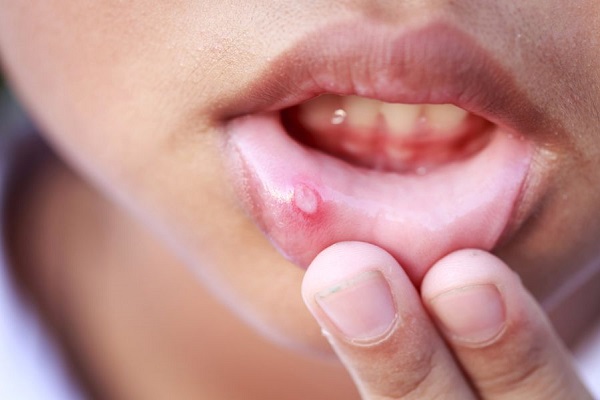
The blisters on the inner lip are also accompanied by low-grade inflammation and pain. It is very important that the blister is maintained intact to avoid complications. However, water blisters can be drained by accident while chewing.
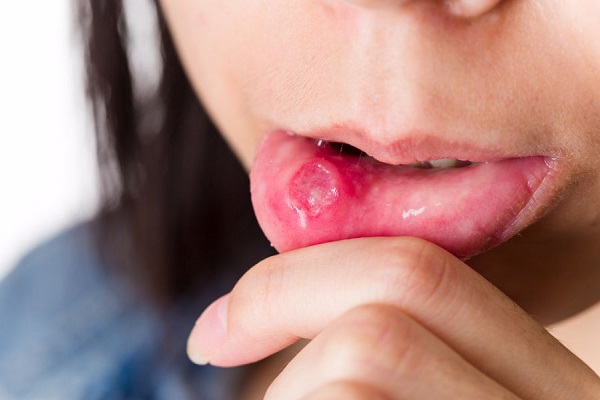
If antiseptics or antibiotics are not applied to the lesion at this point, there is a high chance that it will get infected. When water blisters get infected, they develop into canker sores. The local inflammation around the lesion is more dramatic, and pus may begin to collect. Canker sores are also significantly more painful than water blisters.
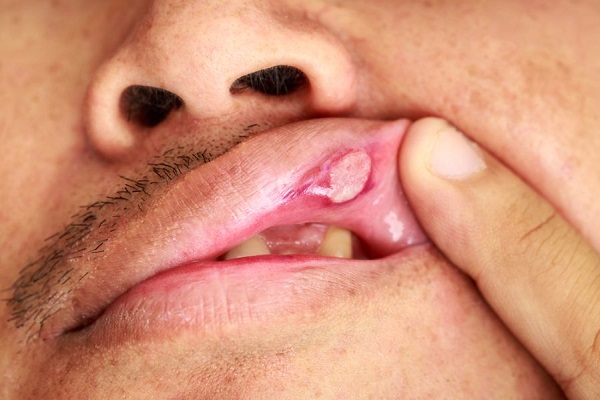
Lip Cancer
Cancerous lesions may appear on the lip, and it is extremely important that patients seek professional medical help as soon as possible. These types of cancers are almost always curable, especially if they are detected in their early stages. The timely diagnosis of lip cancer can ensure better odds of a successful treatment.
Lip Cancer Causes
Lip cancer is a cancerous lesion of the skin that localizes in the lip area. There are numerous causing and predisposing factors that contribute to the development of this lesion. The most important ones are the following:
- Unprotected exposure to the sun
- Smoking
- Alcohol use
- Exposure to certain ingredients in cosmetic products
Lip Cancer Description
In its very first stages, lip cancer can present as a blister on lip lesion. However, as opposed to actual lip blisters, it will not heal even when treatment is applied. This is one of the most important reasons why patients should seek medical assistance if their lip blisters are not healing properly, or if they take longer than expected to heal.
Cancerous lip lesions may also appear thicker than typical lip blisters. Localized bleeding may also appear, and the lesion will display a tendency to erode the lip area. If you notice any of these symptoms, schedule an appointment with your doctor immediately.
Lip Blister Treatment
The first step to a successful treatment for blister on lip lesions is determining which type of lip blister it is. Each of these lesions has a specific treatment plan, and it is very important patients apply these correctly to ensure the proper healing of the blister. In this section of our article, we will describe the main treatment options for each type of blister on lip lesion.
General Considerations
As a general rule, when dealing with blister on lip lesions, patients should not attempt to drain the blisters themselves. Firstly, this could slow down the healing process significantly, which is not a desirable goal.
Secondly, this could expose the patient to local infections, because the inner portion of the blister is very sensitive to bacteria. As such, if the blisters are drained by accident, patients should apply some antibiotic cream to avoid any complications.
In the ideal healing process of a blister, there are two main possibilities. For small-sized blisters, the body can absorb the fluid inside after a few days. For larger blisters, which have gathered a larger amount of fluid, it is more likely that these will be drained naturally. When the lesion is mature enough, it will develop a small fistula, and the liquid will be evacuated.
Fever Blister/Cold Sore Treatment
Since cold sores are caused by a virus, the adequate treatment is antiviral medication. This comes in the form or a cream or gel that patients can apply directly on the lesion. The most efficient antivirals for cold sores are acyclovir, famciclovir, and valacyclovir.
Patients should apply the cream on the lesion until it is fully healed. However, it is very important that they know that the antiviral medication will help cure the symptoms, but not the infection itself. Even after the cold sore heals, patients remain asymptomatic carriers of the HSV-1 virus.
If the cold sores reemerge more than once or twice a year, it is very important that patients seek medical help. Frequently recurring cold sores may signal issues of the immune system. A specialist may also prescribe a more advanced antiviral treatment that is personalized to the patient’s infection.
Water Blister Treatment
The proper treatment for these blister on lip lesions is antibiotic cream. This will help the water blisters heal quicker, and it will prevent more advanced infections (canker sores). Water blisters can also heal without treatment in a few days. However, patients should monitor the lesion and apply antiseptics in case the blister is accidentally drained.
Canker Sore Treatment
These blister on lip lesions present with pus, which means that patients should clean them regularly with an antiseptic solution, such as rubbing alcohol. Patients must also apply an antibiotic cream on the canker sore until it heals entirely.
If the canker sore does not show any signs of improvement after two days of local antibiotic treatment, patients should seek medical help to avoid the development of a more complex infection. Furthermore, if they present several canker sores that are painful, they will need a thorough examination. Depending on the diagnosis, the doctor may prescribe general antibiotics (pills) as well.
Sun Blister Treatment
These blisters are sunburn lesions, which means that they require low-grade burn treatment. Patients must hydrate the area thoroughly with intense hydration creams and monitor the blister throughout its development. They must also apply antibiotic cream to avoid local infections. It is crucial that they keep the burnt area clean at all times.
They should also take anti-inflammatory medicine, such as ibuprofen, to reduce the swelling and the pain of the burn. If the symptoms do not recede after three or more days, they should seek medical help for their sunburns.
Lip Cancer Treatment
Patients should seek professional medical help if their blister on lip lesions take a long time to heal, or develop into deeper lesions. A doctor will conduct a thorough clinical examination to determine the nature of the cancerous lesion, and then develop a treatment plan for the patient.
Skin cancers localized on the lip can be excised in most cases. The rate of success of the treatment is very high for this type of cancer, especially if it is diagnosed in the first stages. Patients should not neglect suspicious lesions, because the early diagnosis of lip cancer will greatly increase their chances at a successful recovery.
How to Prevent Lip Blisters
People can prevent most blister on lip lesions by applying a few simple measures. In this section of our article, we will present the most important preventative measures for each type of lip blister, so that patients can avoid these irritating lesions.
Fever Blister/Cold Sore Prevention
As we have mentioned above, once people contract the HSV-1 virus, they will remain carriers of the virus their entire lives. The best way to prevent cold sores is to maintain a healthy lifestyle and a strong immune system. As such, these are the key prevention methods for cold sores:
- Avoiding stress as much as possible.
- Maintaining a healthy diet that includes immunity boosting foods.
- Rigorous skin care of the lip area.
- Natural ways of boosting the immune system.
Water Blister Prevention
The best way to prevent these blister on lip lesions is avoiding trauma and irritating factors in the inner lip area as best as possible. Moreover, a healthy diet that includes skin nourishing foods can help make the lip more resilient to low-grade trauma.
Canker Sore Prevention
People can prevent canker sores by applying antiseptic solutions (rubbing alcohol) or antibiotic cream to lesions that occur on the lip and in the oral cavity. General prevention methods include immunity boosters, a healthy diet, and rigorous skin care of the lip and oral cavity.
Sun Blister Prevention
The best possible way to prevent sun blisters is to avoid unprotected exposure to intense sunlight. People should apply sunscreen with an SPF factor of at least 50 to their lips and face during summertime to avoid exposure to intense UV rays.
Furthermore, they should reapply the sunscreen every two hours to maintain an efficient protection from the sun. The skin on the face, and especially the lip area, is much more sensitive than the skin on the rest of the body, and, as such, it requires additional protection.
Lip Cancer Prevention
Like sun blisters, skin cancer localized in the lip area can be prevented by avoiding unprotected exposure to intense sunlight. Aside from the rigorous protection from the sun, people can apply these general prevention methods:
- Avoiding harsh cosmetics
- Stop smoking
- Reducing or eliminating alcohol intake
- Maintaining a healthy diet
- Reducing stress as much as possible
Conclusion
In conclusion, blister on lip lesions are extremely common. Nevertheless, patients should never neglect them. It is important that people recognize the difference between cold sores, water blisters, sun blisters, and canker sores, so that they can apply the proper treatment. Patients should monitor their lip blisters, and seek medical help if they notice that these are not healing properly, to avoid complications.
If you have experience with any of these types of lip blisters, share it in a comment down below.

I’ve heard of a few of these, but seriously did not know there were THAT many different types of lip blisters out there! Totally agree, though, with taking care of them ASAP as soon as you notice it. Why wait? It’ll only get worse in my experience.
Hello, Ashley!
We’re glad our article has taught you a bit more about the many types of lip blisters. Thank you for your input!
Have a nice day!